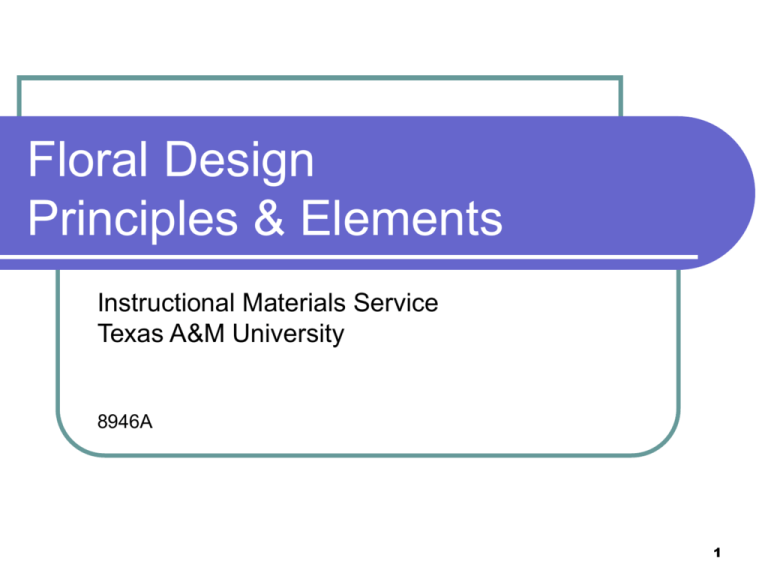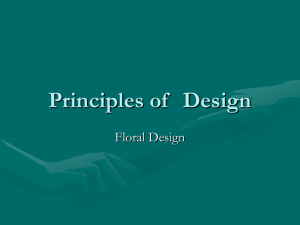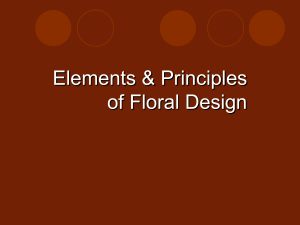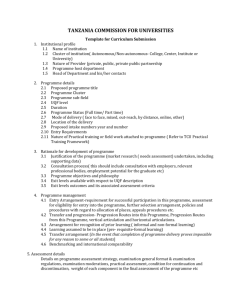
Floral Design
Principles & Elements
Instructional Materials Service
Texas A&M University
8946A
1
Introduction
The principles and elements of design
assist floral designers in selecting
materials and visualizing compositions.
2
Introduction
Design principles and elements are
important in the design and construction
of compositions that are:
Structurally sound
Functional
Aesthetically pleasing
3
Principles of Design
The principles of design are guidelines
that govern the organization of the
elements and materials in accordance
with the laws of nature.
4
Principles of Design
The primary principles of design include:
Balance
Proportion
Dominance
Contrast
Rhythm
Harmony
Unity
5
Balance
Balance is the physical and visual
stability of a floral arrangement.
Physical or mechanical balance refers to
the physical stability of the arrangement.
Visual balance refers to the visual
appearance of the arrangement.
6
Balance
Two types of visual balance are:
Symmetrical balance
Asymmetrical balance
7
Symmetrical Balance
For a symmetrically balanced floral
arrangement:
An equal amount of
materials exists on
either side of an
imaginary central
vertical axis
through the center
of the arrangement.
Central vertical axis
8
Symmetrical Balance
One side of the arrangement is a near
mirror image of the other side.
9
Symmetrical Balance
The focal point exists at the center of the
arrangement, near the base of the vertical
axis.
Focal point
10
Symmetrical Balance
This
visual balance is referred to as
formal balance and has a formal
appearance.
11
Asymmetrical Balance
For an asymmetrically balanced floral
arrangement:
The visual weight
on either side of the
arrangement is not
the same.
12
Asymmetrical Balance
The imaginary vertical axis is to the left or
right of the center of the arrangement,
balancing the visual weight accordingly.
13
Asymmetrical Balance
Visual balance is
achieved by
creating a high
vertical line on one
side of the
arrangement and a
low horizontal line
on the other side.
Vertical line
Horizontal line
14
Asymmetrical Balance
The focal point
exists at the bottom
of the arrangement,
near the base of the
vertical axis, which
is off-centered.
Focal point
15
Asymmetrical Balance
This visual balance is referred to as
informal balance and has a more
informal and natural appearance.
16
Establishing Visual Balance
To establish visual balance in an
arrangement, position larger flowers
with bold, distinctive shapes and darker
colors lower in the arrangement.
17
Establishing Visual Balance
Place darker, heavier colors nearer to
the center of the arrangement.
Light
Dark
Light
Dark
18
Establishing Visual Balance
Smaller flowers with lighter colors and
more delicate textures appear lighter in
weight. Therefore, place these flowers
toward the edges and perimeter of the
arrangement.
19
Proportion & Scale
Proportion is the relationship in size and
quantity among the parts within an
arrangement. Relationships among
flowers, foliage, and the container affect
the proportion of an arrangement.
20
Proportional Standard
The standard commonly used by florists
to achieve a pleasing proportion between
the plant material and the container is to
make the height of an arrangement at
least 1 ½ times the height or width of the
container, whichever is the greater
dimension.
21
Proportioning Stem Lengths
Proportioning stem
length to low container
Proportioning stem
length to tall container
22
Visual Weight
The size and color of flowers and their
positions within an arrangement are also
important for achieving proportion.
Larger and darker colored flowers have
more visual weight than smaller, lighter
colored flowers.
23
Scale
Scale refers to the relationship of an
arrangement with its surroundings.
Larger arrangements are more in scale
in larger, open settings.
24
Dominance / Emphasis
Most floral arrangements consist of one
type of form flower that has more visual
interest or dominance over the other
flower types. This area of strong visual
appeal is the focal point of the
arrangement, attracting the viewer’s
eyes to the arrangement.
25
Dominance / Emphasis
In traditional geometric floral
arrangements, the location of the focal
point is located just above the rim of the
container. The stems of flowers and
foliage making up the arrangement
appear to radiate from this area.
26
Dominance / Emphasis
The size, color, form,
and location of flowers
in the focal area
dominate the other
flowers in the
arrangement.
Focal Point
27
Contrast
Contrast is emphasis by means of
difference.
Contrast adds richness and impact
through opposition. Color and texture are
two means of achieving contrast in an
arrangement.
28
Rhythm
Rhythm gives a design the feeling or
appearance of motion, leading the eye to
the focal point and throughout the
arrangement. Rhythm uses the elements
of form, line, color, and space to develop
the sense of motion.
29
Rhythm
Techniques such
as repetition,
radiation of lines,
and transition are
also effective for
developing rhythm
in an arrangement.
30
Radiation
Radiation provides the illusion that all the
flower stems originate from one growth
point.
31
Transition
Transition involves the gradual change
or progression of plant materials from the
perimeter of an arrangement to the focal
area. Visual movement from the
perimeter of the arrangement to the focal
area occurs due to gradual changes in
flower spacing, size, and facing.
32
Harmony
Harmony is created through the blending
of textures, shapes, and colors in a floral
arrangement. The floral materials in an
arrangement should harmonize with the
container, the style of design, and the
surroundings.
33
Unity
Unity provides a feeling that a design is a
single unit.
Unity in an arrangement occurs when all
the principles and elements blend
together.
34
Elements of Design
The physical characteristics of materials
used in designs make up the elements of
design. Line, form, texture, color, and
space are the traditional elements of
design. Two additional contemporary
design elements are pattern and size.
35
Elements of Design
Combining the properties of the design
elements with the principles of design is
the foundation of successful design.
36
Line
Line is the design element that forms the
structural framework of a floral
composition. It establishes a visual path
and creates motion throughout the
arrangement by encouraging the
viewers’ eyes to travel from one part of
the arrangement to another.
37
Line
The element of line establishes the
structure, shape, movement, and
excitement in the arrangement and
creates the dimensions of height, width,
and depth.
38
Line
In Western style geometric designs,
lines radiate from a central point in an
arrangement. Line directions may be:
Horizontal / Diagonal – relaxed
Vertical – strength
Curved – gentle and softness
39
Line
The use of linear materials in an
arrangement is effective in establishing
line within the arrangement.
40
Line Flowers
41
Line Foliage
42
Form
Form is the overall three-dimensional
external shape of a design. Three basic
forms of geometric floral arrangements
expressed in two-dimensional terms
include the circle, square, and triangle.
43
Texture
Texture refers to the relative
comparisons among the visual and
tactile surface qualities of an object. An
effective design guideline for texture is to
use either a complete blend or a definite
contrast. Repeating or contrasting
textures adds interest and beauty to a
design.
44
Color
Colors of flowers carefully blended and
positioned in an arrangement reflect the
mood of the design.
45
Space
Space includes the area in, around, and
between the materials making up a
design. Use of this design element
prevents crowding of materials and
allows for each flower to be seen. Space
provides an opportunity for the viewers’
eyes to rest, thus giving importance to
line and form.
46
Space
Two types of space exist within a floral
arrangement.
Positive space is
the space occupied
by the flowers and
foliage.
Negative space refers
to the empty areas
that exist between the
floral materials.
Negative space
47
Space
The use of negative space allows the
designer to enhance and draw attention
to particular forms or lines within a
design.
48
Pattern
Pattern is closely related to form and
refers to the silhouette or outline of an
arrangement or flower as observed
against its background. It includes both
positive space and negative space within
the arrangement. Pattern also refers to a
repeated physical characteristic of a
plant material.
49
Pattern
Five standard patterns common to floral
design include:
Round
Oval
Symmetrical triangle
Asymmetrical triangle
Rectangular
50
Pattern
51
Size
Size is a contemporary design element.
It refers to the dimensions of line, form,
and space.
52
Foundation of Floral Design
The foundation of floral design is based
on the natural occurrence of design
principles and elements that exist
together in unity and harmony. Each is
important and interrelated to impact the
entire appearance and visual expression
of an arrangement.
53
Acknowledgements
Jane Gloyd, TMF, AAF, Horticultural Professor (retired),
Richland College, Dallas, Texas organized and developed the
information used in this PowerPoint presentation.
Christine Stetter, Artist, Instructional Materials Service,
developed and illustrated this PowerPoint presentation.
Keith Zamzow, Curriculum Specialist, Instructional Materials
Service, edited and reviewed this PowerPoint presentation.
54
All Rights Reserved
Reproduction or redistribution of all, or part,
of this presentation without written
permission is prohibited.
Instructional Materials Service
Texas A&M University
2588 TAMUS
College Station, Texas 77843-2588
http://www-ims.tamu.edu
2007
55






